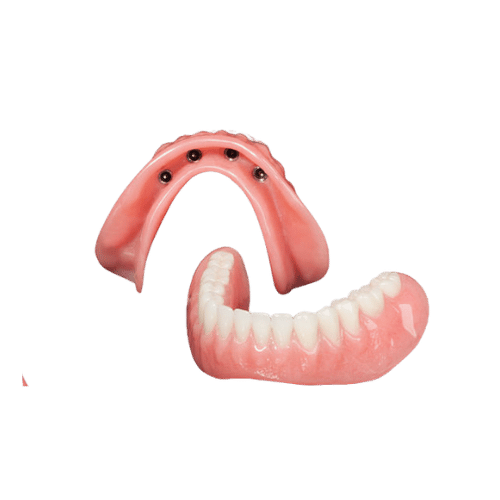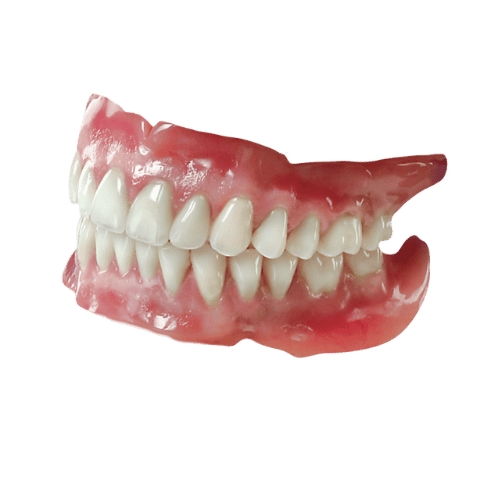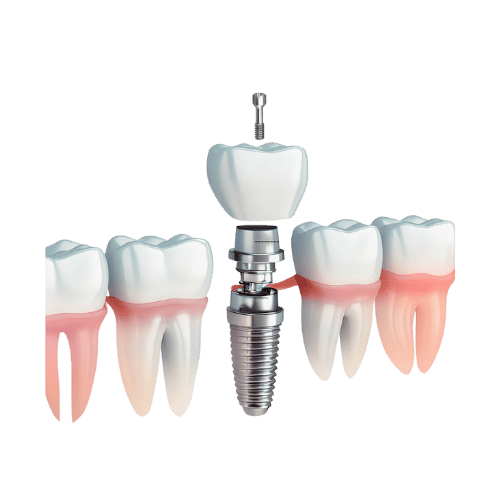Overdentures
Full arch replacement of either upper or lower full arch with a more stable tooth replacement solution from $750 NETT after Medisave subsidy of $7,800.
Acrylic Overdentures
Acrylic overdentures are traditional acrylic snap-in dentures with 4 locators and 4 dental implants holding it into place.
Cobalt Chrome Overdentures
Cobalt-chrome overdentures are a lightweight metal denture framework with 4 locators and 4 dental implants holding it in place.
Overdentures Experience
What Most Patients Say About Overdentures
More Stable Than Dentures
Overdentures attach to dental implants, so they stay securely in place.
Unlike traditional dentures, they will not slip when you talk or eat.
This added stability helps you feel more confident in daily life and reduces the need for denture glue or frequent adjustments.
Better Aesthetics and Functionality
Overdentures are designed to look natural and feel more like real teeth.
They support your facial structure, preventing the sunken appearance that often comes with missing teeth.
You will not only smile better but also chew and speak more naturally, without the awkwardness of loose dentures.
More Comfortable
Because they are supported by dental implants, overdentures put less pressure on your gums.
This means fewer sore spots and less irritation.
Over time, most patients find them more comfortable than traditional dentures, especially after the mouth adjusts to the fit.
Cost-Effective Alternative to Full Implants
While full fixed implant bridges like All-on-X or a full mouth rehabilitation can be expensive, overdentures offer many of the same benefits at a more affordable price.
They require fewer implants and less extensive surgery, making them a practical choice for patients seeking implant stability without the higher cost of full-mouth rehabilitation.
Easier To Clean Than Dental Implants
Overdentures can be removed for daily cleaning, which helps maintain better oral hygiene.
This is especially useful for older patients or caregivers.
for older patients or caregivers. You will not need special tools or flossing techniques. Simply take them out, clean them like regular dentures, and snap them back in when done.
Speak and Chew Properly
Because overdentures are anchored to implants, you can speak clearly and chew with more strength.
You will not have to worry about embarrassing clicks, slurred speech, or avoiding certain foods.
They restore much of the function of natural teeth and help you eat and talk with confidence.
Overdentures Patient Journey at toofus™ Dental
1st Visit: X-rays (OPG)
When you first enter toofus™ Dental for an overdenture consultation, you will be led to take an X-ray (OPG).
Overdentures are held up by dental implants.
The OPG X-ray helps us determine your suitability for dental implants. Key factors that would qualify you for dental implants are strong bone and gum health, with no signs of infection or gum disease.
It also helps your attending dentist see whether there are any other underlying dental conditions you have so that we can better advise you on your oral health and treatment plan.
This also acts as a documentation of your oral health.
toofus™ does not charge for all X-rays (OPG) done at our dental clinic as we believe that X-ray diagnostics help our dentists treat you better.
1st Visit: Consultation and Assessment
During the consultation and assessment, your dental implant dentist will begin taking a thorough look in your mouth and at your teeth.
Overdentures will be suitable if you have extension tooth loss (more than 8 missing teeth with other damaged teeth) and wish to replace them with a “new” set of teeth.
Should the majority of your teeth still be healthy with a few missing teeth, overdentures might not be the best solution for you.
In this case, you might want to consider multiple dental implants instead.
1st Visit: CBCT Scans
Should you wish to proceed with overdentures treatment, CBCT 3D scans are taken of your teeth.
The 3D imaging scans help your dental implant dentist establish the depth and width of your bone.
It also helps us see what diameter the dental implant screw has to be, as well as how it should be angled to avoid critical anatomical structures.
In the case of insufficient bone depth, your dentist will inform you about the need for bone grafting.
At toofus™ Dental, we only use natural bone for our bone grafting procedures. We do not use synthetic bone graft materials as synthetic graft do not absorb as well as natural bone.
1st Visit: Impressions for Immediate Dentures
Immediate denture impressions will be taken.
These immediate denture impressions help both the dentist and yourself.
The immediate dentures help the dentist in establishing your final bite position before the rest of your teeth are extracted and replaced with implants. You on the other hand are able to have a temporal teeth replacement while waiting for the final fixture.
2nd Visit: Guided Biofilm Therapy (GBT)
To increase the success of your implant treatment and prevent the potential for bacterial infection, we do a thorough cleaning of your teeth and gums with Guided Biofilm Therapy (GBT) before placement of the implant.
Guided Biofilm Therapy is a non-invasive dental cleaning that discloses all plaque and tartar on your teeth before gentle cleaning with an airflow system.
2nd Visit: Treat Dental Implants With Plasma
Before the dental implant surgery, we treat each dental implant screw and abutment with cold plasma.
Research studies has shown that treating dental implants with cold plasma can help encourage better wettability, which in turn promotes osseointegration and healing.
2nd Visit: Dental Implant Surgery
During your dental implant surgery, your dentist will first expose the bone under your gums.
A drill is then used to perforate your bone.
The implant screw is then placed into the bone with an abutment above it.
Your dentist will then suture the implant and gums together to set it in place.
In some cases, instead of exposing the abutment, your implant screw might be buried and sutured under your gums instead.
In unique circumstances where your implant site is too close to a critical anatomical structure (e.g. your nerve or a sinus), a guided surgery using a surgical guide may be done.
2nd Visit: Photobiomodulation Therapy (PBM)
Once the suturing process is completed, we use a special laser called Photobiomodulation Therapy (PBM) on the surgical site.
This laser helps promote healing and safeguards against inflammation post-surgery.
2nd Vist: Immediate Dentures are Issued
Once you have completed your dental implant surgery, your immediate dentures will be issued.
You will be advised to use that only when necessary as your implant wounds are still healing.
3rd Visit: Suture Removal and Implant Review
You will return in 2 weeks to remove your sutures and check in on the healing of your dental implant.
4th Visit: Bone Stability and Osseointegration Review
You will return in 3 months after your implant surgery for a bone stability and osseointegration review.
During the visit, your dentist will use an Implant Stability Quotient (ISQ) device to check the stability of your dental implant in the jawbone.
The ISQ device uses Resonance Frequency Analysis (RFA) technology to provide information on how stable your dental implant is in the jawbone.
Higher ISQ values indicate greater stability and osseointegration.
4th Visit: 3D Intraoral Scan for Overdentures
If your implant has fully osseointegrated, a 3D intraoral scan is done of your teeth.
Your dentist will select a shade of your teeth that is most similar to your existing teeth (if there are any left).
The scan and teeth shade is then sent to our dental lab for production.
5th Visit: Overdenture Bridge is Issued
You will return in about 7-14 days for the final issue of your dental implant supported bridge (overdentures).
The final overdentures will be screwed into your implant screw for a fully restored and functional arch,

Total Treatment Duration for Overdentures
The total treatment duration for overdentures usually takes about 3 – 6 months. If gum disease needs to be treated first, the total treatment duration will be extended to 6 – 12 months.
Overdentures Alternatives
If you are not suitable for overdentures, there are other alternative treatments that might work better for you.
1

Dentures
Dentures are removable tooth replacement appliances that are affordable and suitable as a long-term or interim solution if you are unsuitable for dental implants.
2

Single or Multi-Unit Dental Implants
Single or multi-unit dental implants are often used in the event where there is still a lot of healthy teeth left with no need for a full-arch replacement.
3
Dental Bridge
A dental bridge is a fixed and non-removable dental restoration that replaces one or more missing teeth by joining a pontic to adjacent teeth.
Not sure what you are most suitable for?
Overdentures: Frequently Asked Questions
Everything you need to know about overdentures and more.
Can I use Medisave for my overdentures?
Yes, it is possible to use Medisave for the dental implants surgery part of your overdentures procedure if you are a Singaporean or Singaporean PR.
Dental implant surgery is a surgical procedure and allowed for claims.
The total amount of subsidy allowed for each procedure would be up to $1,950 per surgery.
However, it would not be possible to pay for the prosthetic part of the overdentures procedure with Medisave.
How much will my overdentures cost after Medisave subsidy?
Your overdentures will cost $750 per arch after Medisave subsidy.
Our overdentures package includes the following:
- Guided keyhole surgery with surgical guides
- Implant surgery
- 4 dental implants
- Interim immediate dentures
- Overdentures
- Review and follow up visits